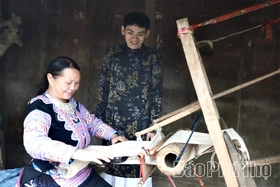{title}
{publish}
{head}
Following the reorganization of commune-level administrative units, the Muong Vang region, formerly part of Lac Son district, was restructured into eight communes: Ngoc Son, Quyet Thang, Thuong Coc, Lac Son, Dai Dong, Yen Phu, Muong Vang, and Nhan Nghia. Despite changes in administrative boundaries and integration into a broader development space, the cultural identity of this “core region” of the Muong ethnic group has remained vibrant and well-preserved. With a population of over 150,000 people, 92% of whom are Muong, Muong Vang is widely recognized as an ancient homeland of the Muong people, where unique cultural features continue to converge and thrive.

Women of Muong Vang communes engaged in traditional Muong games.
At present, the region is home to more than 1,200 Muong gongs and nearly 19,000 traditional stilt houses. It has developed a thriving cultural network including ten folk singing clubs, one Mo Muong club, three poetry clubs, five gong performance clubs, two folk dance and singing clubs, and a Muong ethnic brocade weaving cooperative. The community actively maintains distinctive customs and the culinary essence of the Muong people. Notably, traditional attire continues to be worn in daily life and is an indispensable part of festivals and special occasions. Local festivals are preserved and revived, while a rich system of historical and scenic sites, such as the national relic Hang Xom Trai (Muong Vang commune) and Mai Da Lang Vang (Yen Phu commune), helps anchor Muong identity in the local landscape.
In the face of modern pressures such as commercialization, digital entertainment, and the declining interest of younger generations, many forms of folk games risk being forgotten. However, in the Muong Vang communes, traditional sports and games of the Muong people remain lively and well-supported.
Mrs. Bui Thi Vinh of Ram Co hamlet, Thuong Coc commune, shared, "The Muong people in Muong Vang have always been proud of their heritage. We constantly remind our children to cherish and preserve our cultural legacy. It is heartening to see new generations actively participating in folk games, festivals, and traditional weaving, as well as cultural exchange programs that promote Muong duets, thuong rang, and bo meng with neighboring communes and provinces."
Ms. Bui Thi Tham, a long-time cultural activist and preservationist in the Muong Vang area, affirmed that Muong culture permeates every aspect of spiritual life. She pointed to the regular activities of folk singing clubs as evidence, noting their innovative approaches to promoting Muong heritage online. Community-organized folk games such as mat-beating, glove-beating, stilt walking, crossbow shooting, stick pushing, and tug-of-war continue to attract strong participation across all age groups.
In recent years, the support of the Party and State through concrete policies and guidance has been instrumental in preserving and promoting Muong cultural values and the broader "Hoa Binh Culture." Local authorities and organizations have shown great commitment in directing and implementing cultural initiatives. Nine traditional festivals have been successfully restored in the region, including the Du Voi Festival, But Hang Khu Dung Festival, and Xuong Dong Festival. Annual gatherings are held to honor artisans, researchers, collectors, and practitioners of traditional culture.
As part of Project 6 on “Preserving and Promoting the Fine Traditional Cultural Values of Ethnic Minorities Associated with Tourism Development,” the government has provided traditional musical instruments, costumes for performance troupes, and Muong mo attire for cultural clubs. Regular festivals, heritage classes, sports competitions, and cultural exchanges continue to be organized. These efforts have created meaningful platforms for artisans to practice and pass on their skills, ensuring that folk traditions are nurtured not only as heritage but also as a vibrant part of contemporary life.
Bui Minh

baophutho.vn On December 8, 2017, at its 12th session, the UNESCO Intergovernmental Committee for the Safeguarding of Intangible Cultural Heritage...

baophutho.vn Situated in the fertile land of Binh Nguyen (Vinh Phuc), the Huong Canh Communal House Complex — comprising Huong Canh, Ngoc Canh and Tien...

baophutho.vn For generations, whenever people mention Huong Canh Town (former Binh Xuyen District, Vinh Phuc Province), now Binh Nguyen Commune of Phu Tho...

baophutho.vn Kha Cuu Commune was formed by merging three former communes: Dong Cuu, Thuong Cuu, and Kha Cuu, with the Muong ethnic group accounting for over...

baophutho.vn Perched atop Tram Linh Hill, Quoc Te Temple in the former Di Nau Commune — now Tho Van Commune — has long been regarded as a solemn and...

baophutho.vn Located in Giap Lai Commune, this ancient communal house is revered by local residents as the “soul of the Muong village.” It is dedicated to...

baophutho.vn The Thai people are the largest indigenous ethnic group in Mai Chau District, now residing mainly in communes such as Mai Chau, Bao La, Mai Ha,...

baophutho.vn Today, Phu Tho Province is home to hundreds of traditional craft villages — from wood carving, blacksmithing, and bamboo weaving to mechanics,...

baophutho.vn In line with the orientation toward tourism-based economic development, the traditional brocade weaving craft of the Mong ethnic group in Pa Co...

baophutho.vn On the morning of October 25, the opening ceremony of the Mien Doi Terraced Fields Festival 2025 took place in Thuong Coc Commune.